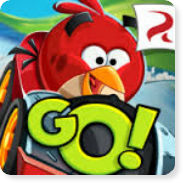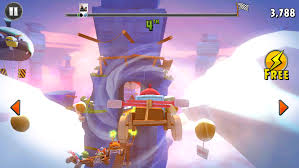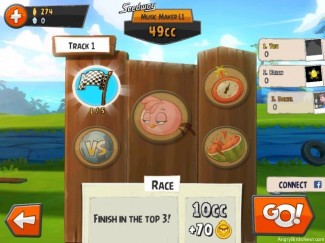Bastion
LQ: 9.15
Recommended Age: 10+
Skills Used: Planning, Working Memory, Mathematics, Reading

Angry Birds Go! is a racing game from Rovio’s popular Angry Birds series. Quite different from the traditional sling-shot style of play employed by the familiar gaming series, this racing game tasks players with collecting coins to purchase upgrades for their vehicles. As gameplay continues, opponents become more difficult to beat, requiring players to collect a surplus of coins and gems so they can purchase the necessary upgrades to win. Each series of levels has a unique terrain, for which players will have to buy new styles of cars in order to gain access. Players are allowed two types of play: tilt screen, in which players rotate the mobile device to turn the car, or touch screen, wherein players simply tap right or left to steer. Gameplay is easy to learn with no inappropriate content, and no academic skills are needed to play, making Angry Birds Go! suitable for children 6 and older.
Adapting and adjusting to changing conditions and expectations.
 With each new level, players are constantly challenged to adapt to the different twists, turns, and shortcuts of the varying terrain. Every level has its own set of unique objectives, which players must complete to collect coins. There are different kinds of races, each requiring a specific style of play, with some races requiring players to finish a race as quickly as possible -- with little regard for coins -- while others force players to collect coins or defeat a single or group of opponents. Time behind the wheel in Angry Birds Go! is characterized by instances in which players must think on their feet and adapt to constantly-changing playing conditions.
With each new level, players are constantly challenged to adapt to the different twists, turns, and shortcuts of the varying terrain. Every level has its own set of unique objectives, which players must complete to collect coins. There are different kinds of races, each requiring a specific style of play, with some races requiring players to finish a race as quickly as possible -- with little regard for coins -- while others force players to collect coins or defeat a single or group of opponents. Time behind the wheel in Angry Birds Go! is characterized by instances in which players must think on their feet and adapt to constantly-changing playing conditions.
Getting started and then maintaining attention and effort to tasks.
Every one of Angry Bird’s Go!'s objectives offers engaging ways for players to set goals and work persistently until they are completed. This kind of goal-directed persistence helps kids see an endeavor through to completion, making it an essential part of the Focus thinking skill. Not only must players focus their attention on navigating safely through the courses, they also need to keep in mind the objectives and make certain they are a priority. Players are presented with unique objectives in each level and the order in which they complete them is up to the player, but if they are neglected, players will fail to advance and they will run out of the gems necessary to revive their characters. Concentration on the objectives, coupled with a strong sense of goal-directed persistence, will help users win races as well as practice to become more focused thinkers.
Being efficient and aware of our use of time and effort.

In each level of Angry Birds Go! there is a timed objective, requiring players to finish a race before “the fuse blows” and ends the game. Players must navigate the level in the most time-efficient manner – taking sharp turns, using speed boosts, and properly upgrading the vehicle while coins and items spread throughout the level lure players away from the fastest route. There is no way to slow the speed of the fuse, so players must devise a strategy for approaching the race and seek alternative methods for shaving off even fractions of a second to improve their time.
Recalling and retaining information in our mind while working.
Learning the layout of each track in the game helps immensely, not only in achieving each of the unique goals level to level, but also in helping improve race time. By being able to anticipate difficult turns, players will know when it is appropriate to slow their vehicle accordingly, while straight-aways offer the perfect opportunity for using speed-boosting power-ups. Being able to recall this information mid-race can greatly benefit race performance and prevent disaster.
Use this PlayTogether guide to learn how you can help your child to turn Angry Birds Go! play time into a positive learning and relationship-building experience. To learn more about why playing games with your children is so important, check out our Science of Play page.
Take a minute to talk to your child about how the Flexibility, Focus, Time Management and Working Memory thinking skills work, and why they are important for success in school and at home.
 Angry Birds Go! is a single-player game, so take turns attempting each objective by passing the mobile device back and forth. After reading over the Thinking Skills pages, team up with your child to take turns completing levels in an effort to achieve the objectives listed below.
Angry Birds Go! is a single-player game, so take turns attempting each objective by passing the mobile device back and forth. After reading over the Thinking Skills pages, team up with your child to take turns completing levels in an effort to achieve the objectives listed below.
Gameplay Goals:
After you have unlocked the pink bird as a character, pause the game and talk with your child about how the game is exercising thinking skills.
Our Make it Work activities are designed to transform your child’s gameplay into real-world improvements in thinking and academic skills. If you’re just getting started with LearningWorks for Kids, we suggest you try them all to find which are the best for you and your child.
Read over the pages for Flexibility, Focus, Time Management, and Working Memory, and then take some time to introduce these Thinking Skills to your child.
Explain That:

Get unstuck. Inflexibility can prevent you from finding a range of correct solutions to a particular problem. One way to help your child see how this behavior results in avoidable frustration is to have her help you out of a situation where you feel stuck. Using the computer is an ideal opportunity for this type of hands-on illustration. Next time you have a problem, keep repeating the incorrect activity or an ineffective remedy, then blame the machine. Tell your child it is the computer that is stuck. Most children are more knowledgeable about computers than their parents and will be able to demonstrate several ways to fix the problem.
Encourage your child to assess what helps the most. Before homework, chores or even favorite activities, ask your child what would help her to complete the chosen task. Ask her to think about the tools, time frame and settings that would encourage planning skills and that would reduce conflict. Advise her to learn to ask these questions of herself on a regular basis.

Set reasonable time limits for tasks and then work to reduce them. For example, state the expectation that your child can unload the dishwasher or clear off the table within 15 minutes. As you work towards decreasing the limit to ten minutes, praise any efforts and attempts to complete this task more efficiently.
Go slow, but when necessary, go fast. Many individuals with Working Memory difficulties need a bit more time to process directions that are given to them, whether they be verbal or written. Allow your child extra time to process this information and also allow extra time for task completion. However, going fast can occasionally be helpful as well. For children who are only able to retain information for a short period of time, you may want to encourage them to complete two to three tasks very quickly so they don’t forget what they are supposed to do.
All membership plans come with full access to our entire suite of tools learning guides, and resources. Here are a few of the ones we think you’ll like the most: